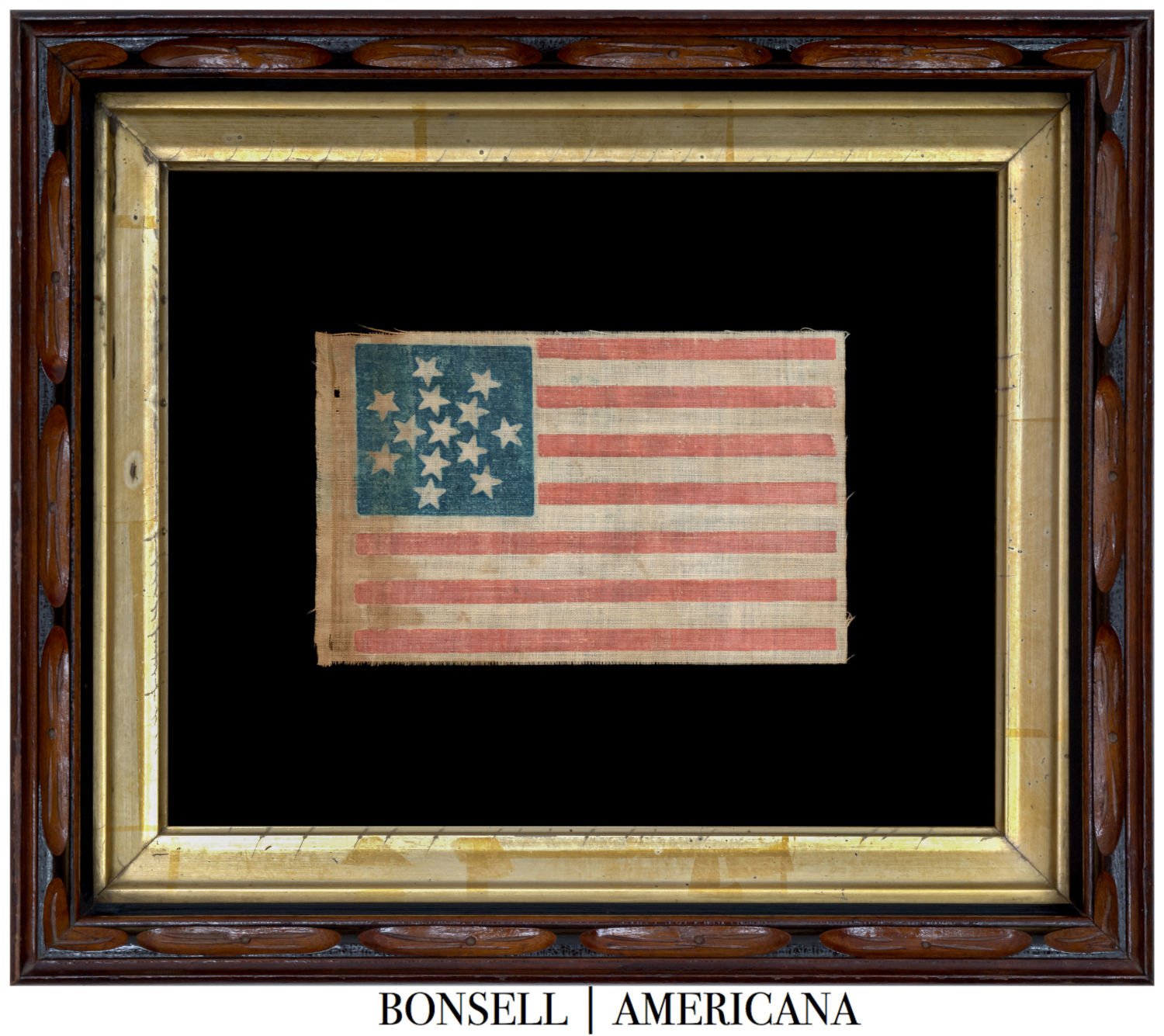13 Star Antique US Parade Flag with a Star of David Configuration | Circa 1860-1890
13 Star Antique US Parade Flag with a Star of David Configuration | Circa 1860-1890
Frame Size (H x L): 17.5” x 13”
Flag Size (H x L): 2.5” x 4.5” and Affixed to an 8.5” Staff
Offered is a thirteen-star antique parade flag, dating to between 1860 and 1890 and exhibiting a rare six-pointed star pattern. This six-pointed star pattern defines a Great Star, a term used to refer to a star made of smaller stars. The reason for including a six-pointed star is unknown, but can likely be explained in one of the two following ways:
As a first theory, the six-pointed star may represent the six-pointed star over the Great Seal of the United States. The Great Seal, as shown in one of the images, is meant to authenticate documents issued by the Federal Government and dates to 1782. Francis Hopkinson played a key role in designing the Great Seal, and is also credited by most historians as being the designer of the United States’ flag (not Betsy Ross). Original sketches of the stars on the Great Seal were randomly placed, but the engraver of the original Great Seal die chose a six-pointed star design, based on English Heraldry.
As a second, alternative theory, the six-pointed star may represent the Star of David, a symbol of modern Judaism, and a reference based on the Biblical King and his shield. The original use of the Star of David dates back hundreds of years, and was used to mark ancestry and decorate books, for example. Beginning in the 19th century, however, European Jews began using the Star of David as a religious symbol, particularly after integrating into Christian communities. This timing is consistent with the age of this flag (1860-1890). In addition, the shade of the blue canton is consistent with the shade of the standard Star of David. While antique flags exhibit a variety of unique colors, this particular shade of the blue canton is quite unique in our experience, and provides support for this second theory.
While we may never know whether this flag was made to align with our first theory or our second, what we can say for sure is that this flag exhibits one of the rarest configurations that one can encounter on a thirteen-star flag.
The original use of the thirteen-star flag dates to June 14th, 1777, the time at which the Continental Congress adopted a resolution creating the first official flag. The resolution stated, “Resolved, that the flag of the United States be made of thirteen stripes, alternate red and white, that the union be thirteen stars, white on a blue field, representing a new constellation.” Thirteen-star flags were official from 1777-1795, but have been in use ever since.
Small US Navy boats used it as the ensign from 1795 until 1916. Thirteen-star flags were also flown at the time of George Washington’s death in 1799 and to celebrate the nation’s 50th anniversary in 1824. They were also flown in 1824 in honor of General Lafayette’s return to the US for his nationwide tour. Celebrations for his Revolutionary War service were held in New York, Boston, and Philadelphia, along with many locations in the southern and western states.
Further, thirteen-star flags were also common during the Mexican War in 1846-1848 and the Civil War in 1861-1865. They were both relatively close in time to the revolution, and were very patriotic times, particularly during the Civil War time period when flag use became much more common than had ever previously been the case. Thirteen-star flags were also flown during the centennial celebrations, which were held across the country and, most notably, in Philadelphia at the Centennial International Exhibition.
Conservation Process: This flag was hand sewn to cotton fabric, and both were hand sewn to a mounting board. To prevent the black dye in the cotton fabric from seeping into the flag, it was first washed in a standard wash and then in a dye setting wash. The flag is positioned behind Conservation Clear Acrylic (standard) or behind Optium Museum Acrylic (per request).
Frame: The Eastlake style frame dates to between approximately 1870 and 1880.
Condition Report: The flag exhibits a small tear along the upper left corner of the canton. In other respects, it is in excellent condition.
Collectability Level: The Great – Perfect for Rising Collectors
Date of Origin: 1860-1890
Number of Stars: 13
Associated War: The Civil War (1861-1865)
Associated State: Original 13 Colonies









